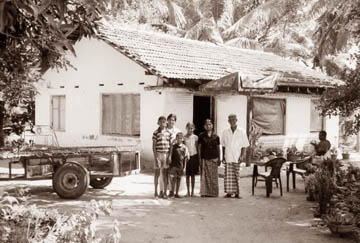|
observer |
|
|
|
|
|
OTHER LINKS |

|

|

|
Giritale farmers need more hands to till, sow and harvest their land
The village of Giritale is sandwiched between the massive Giritale irrigation tank and Polonnaruwa. The kingdom of Polonnaruwa was founded by Parakramabahu the Great, in medieval Sri Lanka. Parakramabahu is undisputedly, the greatest monarch the island had known. He left Anuradhapura and pitched his capital city in Polonnaruwa, intent on securing the island against invasion from India. The Mahawansa speaks of Giritalla Nuwara, nuwara means city, which existed during the Anuradhapura period. Be that as it was, it would have been easier for Parakramabahu to shift his capital to Polonnaruwa, where the environs contained an agricultural infrastructure. The history of Sri Lanka repeats itself as kingdoms and capital cities and agricultural infrastructure are being set up, only to be destroyed by invaders from outside the island, and a lesser number of times, by other kingdoms within the country. In all instances, the jungle tide swept through the ghost cities left behind, including its cultivated land. Giritale lies in the current Minneriya, constituency. In 1956, the Member of Parliament for Minneriya and Minister of Agriculture, the late, C. P. de Silva, had some land which had belonged to an ancient monastery, cleared. The land was handed over to farmers, according to the people with living memory, who live, here. One such recipient farmer, is W. G. Navarathna, now 85, who lived in Alahara, 19 miles away. First, he cleared the thicket and settled down in 1958. Navarathna's son, W. G. Samarakoon 55, the second generation farmer, recalled his marriage, in 1981, to Chandra Kumar. Chandra's parents, also settled down in the environs of Giritale, in 1956, having left their native Matale, behind. Samarakoon and Chandra who are third-generation settlers in this colony make up three boys and a girl. The eldest of Samarakoon's children, a young man of 23, was away in a Buddhist temple, observing sil; it being a full moon day. During the Maha paddy season, rice is the only crop cultivated, here. The Yala, being the lesser agricultural term, is now on. Besides, rice, the villagers here, utilise their land to grow a variety of crops as green gram, peanuts, corn and the like. Vegetables, are also grown, here. From three acres of paddy land, 5,000 kilograms of rice could be harvested. Government buys 3,000 kilos of rice at Rs. 16.50 to Rs. 17.50 per kilo. The private-sector buys rice at Rs. 9 to Rs 11 per kilo. Times are hard, and has always been so, while labour is intensive. Samarakoon and Chandra want their children to do well in school, and seek employment outside agriculture. But, thus far, their children have shown no special aptitudes in learning. With every new generation, the land/man ratio dwindles and there will come a day, not in the distant future, when the land will not be able to sustain the increasing rural population. In the developed world, this phenomenon is countered with the setting up of agricultural industries, close to the farmlands. In Sri Lanka agro industry is far more laboured than agriculture. Such, being the situation, in much of the Third World, did Samarakoon and Chandra, in their pro-creative days, not consider four children, as too many to live off their land? The poor farmers understood the question, but were puzzled when it came to answering the query. The explanation came from Rev. D. Sumana Jothi Thera, of the nearby, Sri Sellathara Aiyayathana Buddhist Temple. "Farmers find that they need more hands to till, sow and harvest," the monk said. |








